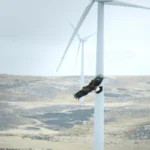
Golden Eagles are listed as Endangered in New York, and are among the species at risk from poorly sited wind turbines. Photo Taylor Berge/Shutterstock
New York released draft regulations in September 2020 to implement the Accelerated Renewable Energy Growth and Community Benefit Act, which was passed into law earlier this year (in April 2020). Twenty-five conservation groups, including ABC, have expressed concern about these draft regulations, which do little to address renewable energy projects’ substantial negative impacts on birds.
The groups propose commonsense solutions that would correct some of the regulations’ major flaws and provide better protection for birds. By incorporating the recommended changes from these bird conservation experts, the State could set a positive precedent for environmentally friendly renewable energy development. But to make this happen, substantial revisions to the current draft regulations would be needed.
The Accelerated Renewable Energy Growth and Community Benefit Act is intended to streamline the approval process for wind and solar energy projects as part of the State’s approach to achieving its renewable energy goals. Among other things, the law established a new Office of Renewable Energy Siting (ORES), charged with developing and overseeing the process for renewable energy project development.
In September, the ORES released draft regulations to implement the Act. “Implementation of this major new regulation has proceeded at a breakneck pace,” says Joel Merriman, ABC’s Bird-Smart Wind Energy Campaign Director. “Unfortunately, in the draft regulations, very little consideration is given to bird protection. We fully support renewable energy development as part of a broader strategy for combating climate change, but this has to be done in an environmentally responsible manner. That includes taking care of our birds, and so far these regulations fall far short in this area.”
Wind energy development is an important element of fighting climate change, but it does not come without environmental costs. ABC estimates that more than 500,000 birds are killed annually from collisions with wind turbines in the U.S. Given projected industry build-out, that figure is expected to increase to more than 1.4 million annually by 2030. Birds are also killed by powerlines installed to connect wind facilities to the energy grid, and yet others are displaced by facility development. Some species, such as Golden Eagles, are more vulnerable to turbine collisions, and due to slow reproductive rates, these birds have less capacity to recover from losses.
“When the law was being considered, we expressed serious concerns,” says Merriman. “Now that we have seen the draft regulations to implement the law, it’s worse than we feared.”
The draft regulations are paired with uniform standards and conditions for project siting and planning. They lack adequate protections for birds, including appropriate project siting, field studies, and other steps that, if established in the law, would conceivably result in an environmentally balanced approach.
“The draft regulations don’t allow enough time for necessary field studies for wildlife,” says Merriman. “They also dramatically reduce the opportunity for public and expert input in the planning process, and they ignore considerations for the majority of bird species. Worst of all, there is nothing to influence where projects are sited, which is the most important aspect of minimizing impacts to wildlife. This is why we worked with other concerned conservation organizations to clearly articulate the problems with this proposed process, and how some of them might be addressed.”
A total of 25 conservation organizations signed a letter to the State outlining the many deficiencies in the draft regulations. “It’s possible to work around some of the biggest issues in ways that will minimize negative impacts to birds,” says Merriman. “For example, if wildlife field studies are required before a pre-application meeting, there may be enough information to make smart planning decisions in many instances. This is the way things already work in the wind energy industry – it’s no burden to developers and results in better outcomes.”
Merriman continues, “It’s hard to understand: In other arenas, New York has done great things for birds. The State can maintain this commitment by making some improvements to the draft regulations, such as establishing commonsense setbacks from high biodiversity areas and requiring some already-standard field studies to inform project planning. It’s critical that we balance the need for renewable energy development with protecting our vulnerable bird populations.”
ABC thanks the Leon Levy Foundation for its support of ABC’s Bird-Smart Wind Energy Campaign.
###
Media Contact: Jordan Rutter, Director of Public Relations, 202-888-7472 | jerutter@abcbirds.org | @JERutter
Expert Contact: Joel Merriman, Bird-Smart Wind Energy Campaign Director | jmerriman@abcbirds.org
American Bird Conservancy is a nonprofit organization dedicated to conserving birds and their habitats throughout the Americas. With an emphasis on achieving results and working in partnership, we take on the greatest problems facing birds today, innovating and building on rapid advancements in science to halt extinctions, protect habitats, eliminate threats, and build capacity for bird conservation. Find us on abcbirds.org, Facebook, Instagram, and Twitter (@ABCbirds).